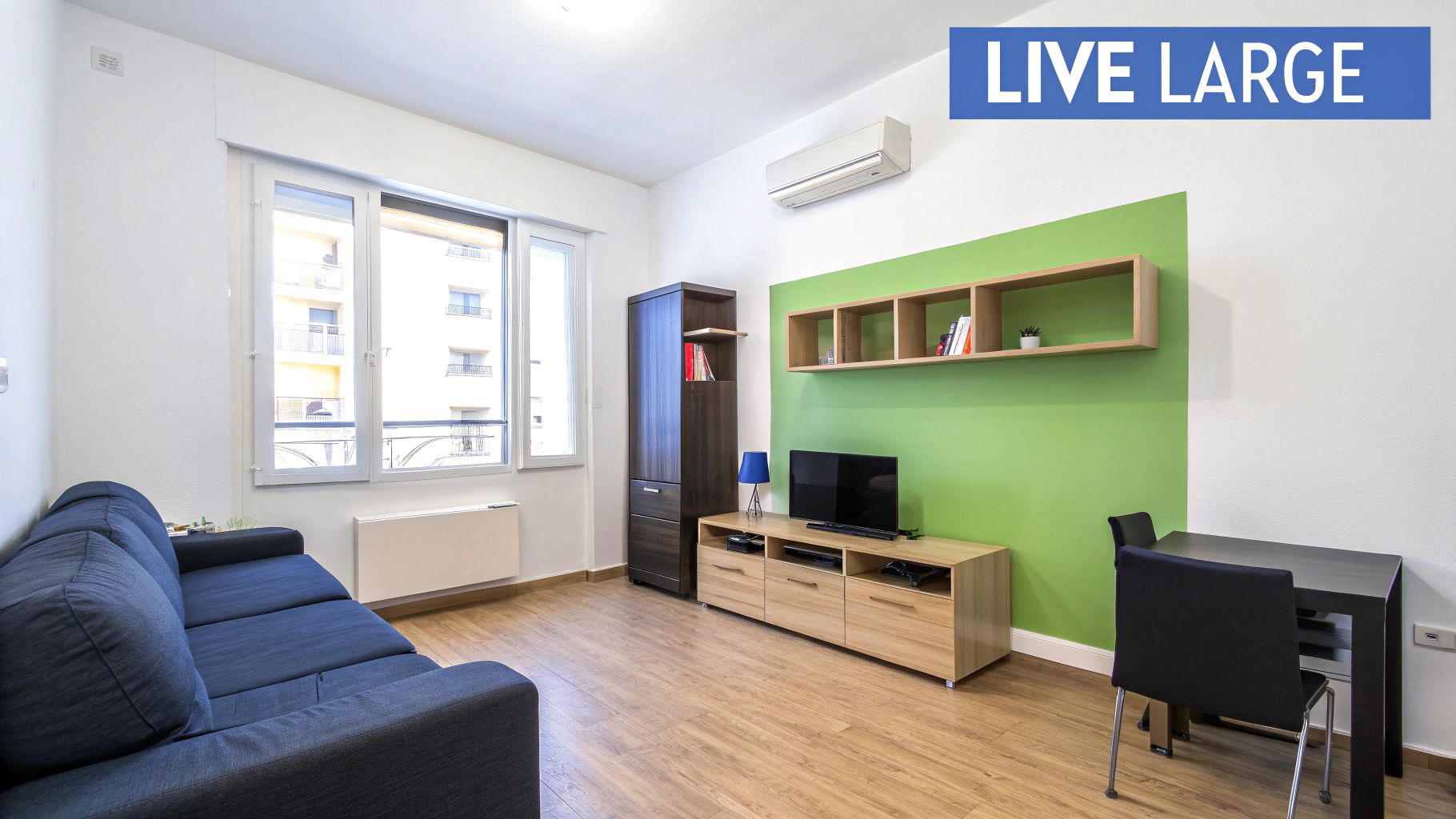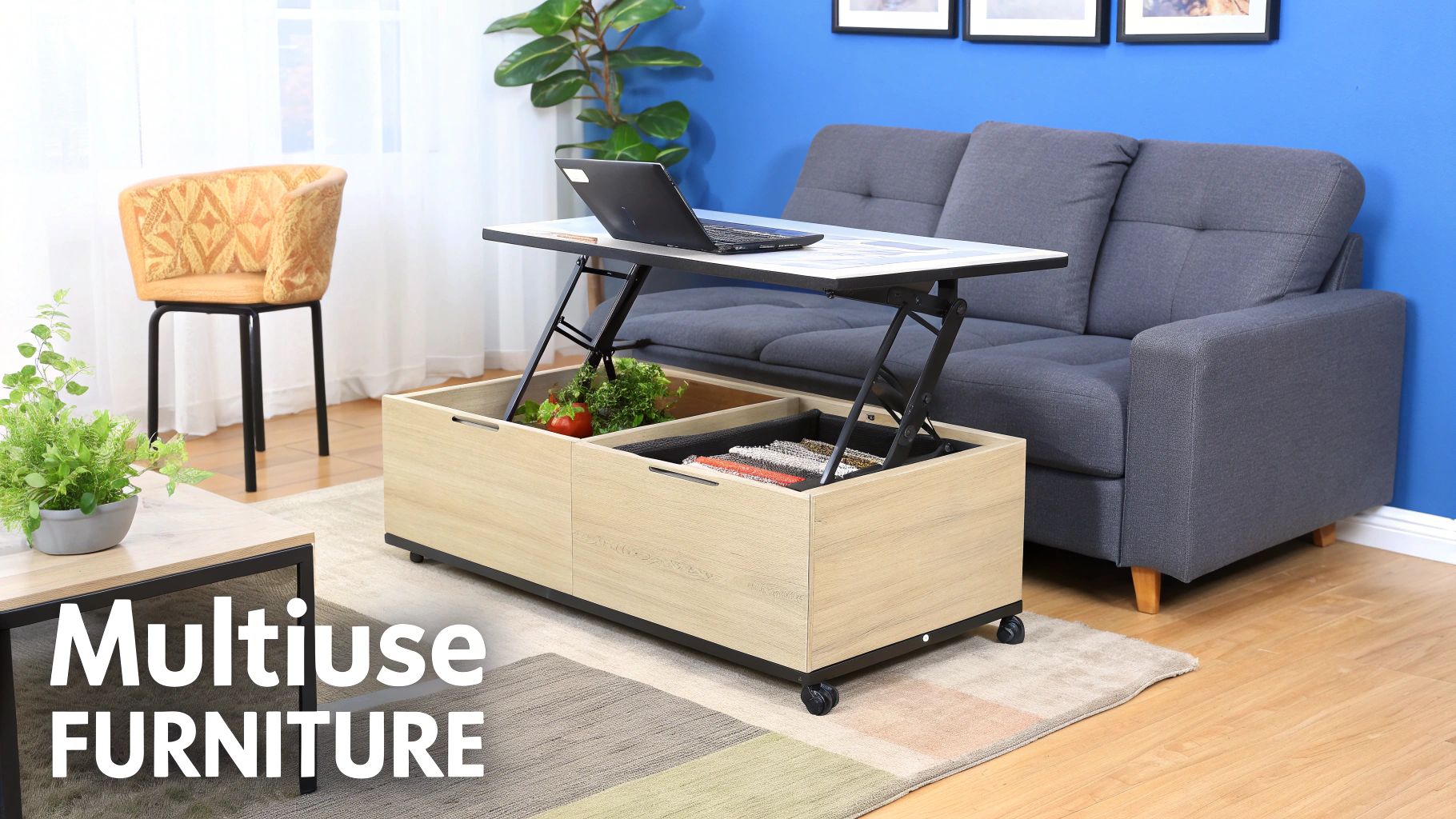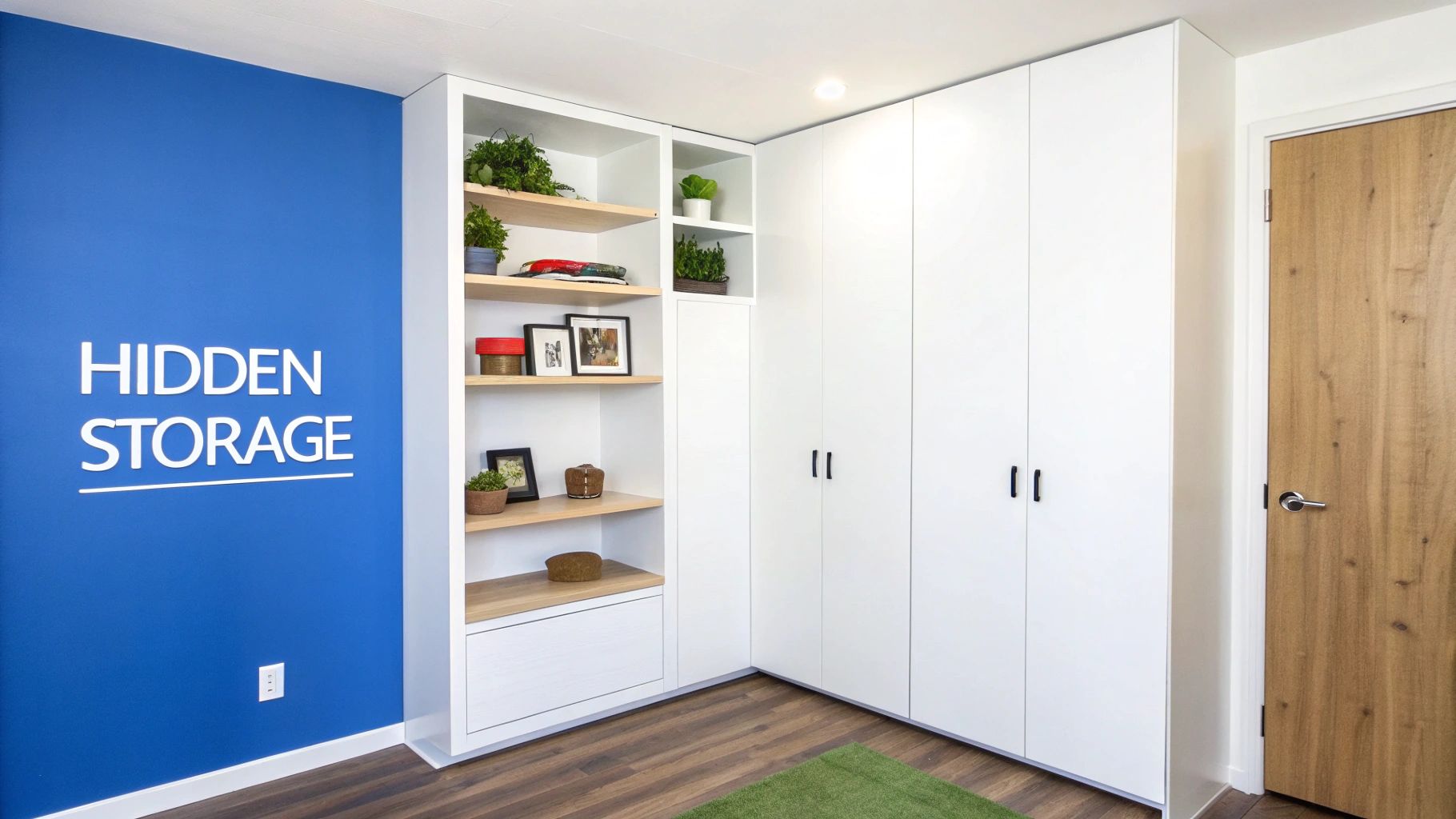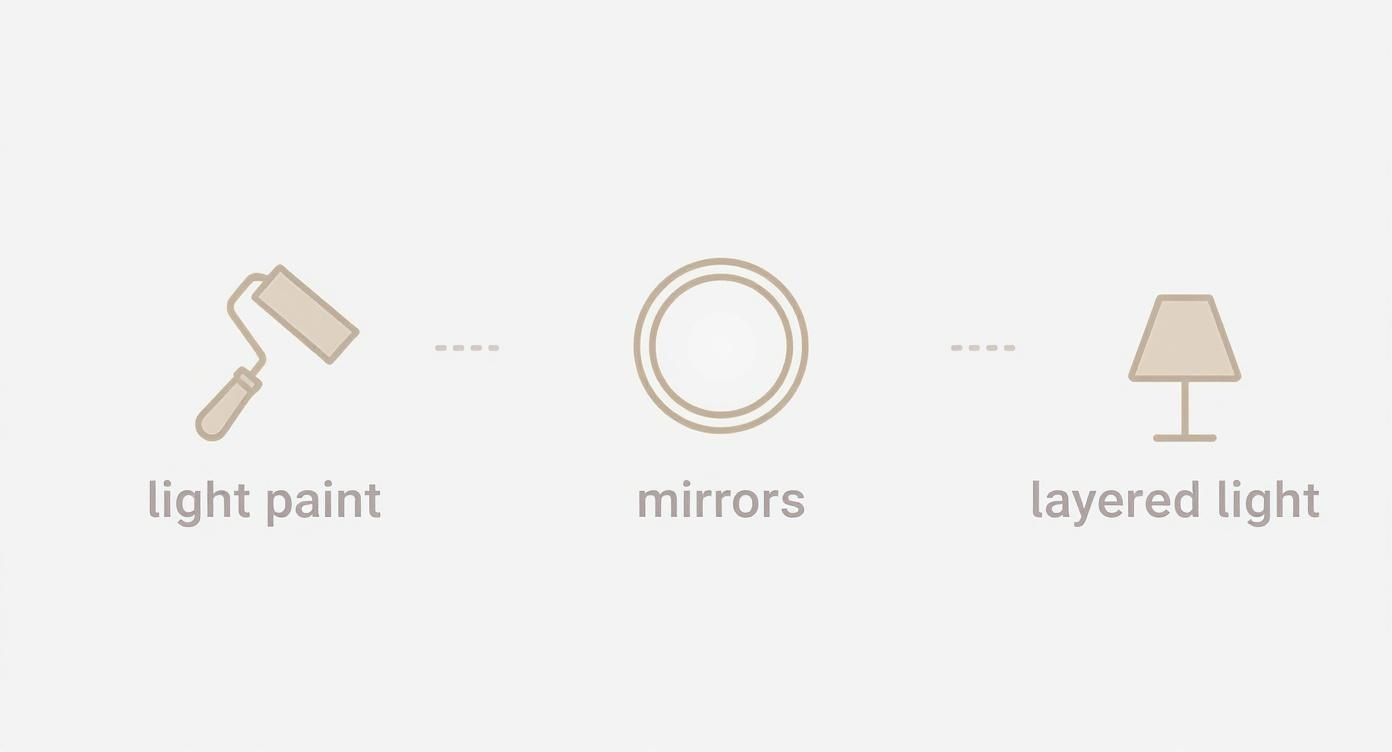How to Maximize Small Spaces with Clever Design Ideas
- Justin McCurdy

- Nov 1
- 14 min read
Feeling closed in by your own four walls? I get it. The good news is that the solution is usually simpler than you think. A few smart design choices can completely transform a cramped room into a space that feels functional, airy, and a whole lot bigger.
It all comes down to a clever mix of multifunctional furniture, vertical storage, and strategic use of light and color. These aren't just buzzwords; they're the practical tools we'll use to create an illusion of openness that you can actually feel.
Living Large In A Small Footprint

You don’t need to knock down walls or start house hunting to get more room. What you need is a smarter plan for the space you already own. We're going to skip the vague, fluffy advice and get right into the real-world tips I've seen make a tangible difference time and time again.
The goal here isn't just about making your home look bigger—it's about making it work better for your actual life. It's about being intentional with every choice, from the coffee table you pick to the paint you roll on the walls.
Before we get into the nitty-gritty, let's look at the big-picture strategies that will make the most impact right away.
Quick Wins For A More Spacious Home
This table gives you a quick look at the core strategies we'll cover. Think of these as the foundational principles to immediately make any room feel larger and more open.
Getting a handle on these three pillars is the secret to unlocking your home's hidden potential. Now, let's explore them a bit more.
The Foundation Of A Spacious Home
The best designs for small spaces are built on a few core principles that work together to trick the eye and create a natural sense of flow.
Go Vertical: When you can't build out, build up. Drawing the eye upward with tall bookshelves or floor-to-ceiling curtains really emphasizes a room's height, instantly making it feel less boxed-in. A practical example is using a tall, narrow "ladder" bookshelf in a tight corner to hold books and plants.
Embrace Light: Light, both natural and artificial, is your absolute best friend in a small space. Light wall colors, strategically placed mirrors, and layered lighting schemes are game-changers for making a room feel brighter and way more expansive. For instance, placing a floor lamp behind a chair can illuminate a dark corner and make the whole room feel bigger.
Declutter Deliberately: Clutter is the number one enemy of a small home. Good organization isn't about hiding your stuff; it’s about creating a clean, visually restful environment where your mind can relax. Getting serious about smart storage solutions for small spaces is a must.
The real secret to making a small space work is ensuring every single item has a purpose and a place. When your furniture and decor can serve multiple functions, you naturally cut down on clutter and get more out of every square foot.
Your Personal Design Journey
Maximizing your space is a personal journey—what works for a minimalist in a studio apartment might not work for a family of four. It’s all about tailoring these ideas to fit your needs.
If you are in the market for a new home, this is where the magic really happens. While the builder I represent provides high-quality homes, I go a step further—offering my clients unique proprietary visualization tools, hands-on service, and access to visualizers that help you bring your dream space to life. In our communities across White Marsh, Maryland; Edgewood, Maryland, Baltimore County, Maryland; Harford County, Maryland; and Price George's County, Maryland, we let buyers customize their homes by getting to pick their flooring, countertops, cabinets, and tile.
Imagine selecting a light-colored, wide-plank flooring to make your living area feel more expansive, or choosing sleek, flat-panel cabinets that reduce visual clutter right from the start. My visualization tools let you see exactly how these choices impact the feel of your space, so you can be confident your new home is both beautiful and incredibly functional. For even more ideas, check out our guide on 10 open floor plan design ideas to inspire your 2025 home.
2. Choose Furniture That Works Overtime

When you're working with a small footprint, every single item you bring into your home needs to earn its keep. This is where the real magic happens. Forget about furniture that only does one thing. We're talking about smart, hardworking pieces that pull double—or even triple—duty.
Think way beyond the classic sofa bed. Picture a sleek coffee table that smoothly lifts up to become a dining spot for two or the perfect work-from-home desk. Or what about that stylish ottoman where you kick up your feet? It should also be secretly stashing away your extra blankets, board games, and pillows.
Choosing furniture that adapts to your life is how you make a single room feel like three. It's not about cramming more stuff in; it’s about making your space more versatile without adding an ounce of clutter.
The Rise Of Smart Furniture
It’s no surprise that this kind of adaptable furniture is becoming wildly popular. The global market for small space furniture was valued at a whopping USD 23.4 billion in 2023 and is on track to nearly double by 2032. It’s all driven by more of us moving into cities and wanting our homes to be as flexible as our lives are. If you’re curious, you can dig into the market trends for small space solutions yourself.
This isn't just about shrinking down big furniture. It's a complete rethink of how our furniture can serve us. Modular sofas can be rearranged for movie night or split apart to accommodate overnight guests. A platform bed with built-in drawers can completely eliminate the need for a bulky, separate dresser.
The best multifunctional furniture doesn't just save space—it adds possibilities. A dining table that expands or a console that flips open into a desk gives you options you didn't have before, making your home feel more dynamic and responsive to your life.
Practical Examples To Look For
So, what should you actually be looking for? It's all about spotting that hidden potential. Here are a few of my go-to recommendations for furniture that works overtime:
The Lift-Top Coffee Table: Honestly, this one is a game-changer. It functions as a normal coffee table day-to-day, but then it rises to the occasion—literally. It becomes a surface for eating, working on your laptop, or even kids' crafts, saving you from needing a dedicated desk or dining table.
Storage Benches and Ottomans: These are masters of disguise. Perfect for an entryway or at the foot of your bed, they give you a place to sit while hiding away shoes, bags, or extra linens. For example, an entryway bench can hold winter hats and gloves, keeping your closet free.
Nesting Side Tables: Instead of one big end table, a set of nesting tables gives you so much more flexibility. You can spread them out when company comes over and then tuck them away neatly afterward. They provide surfaces when you need them without taking up a permanent footprint.
Bringing The Vision To Life
When I work with clients looking at new homes in communities like White Marsh or anywhere in Baltimore County, we start thinking this way from the ground up. By selecting the right flooring, cabinets, and finishes first, we create a beautiful, cohesive backdrop for this kind of smart, adaptable furniture.
My unique visualization tools really help here. They let you see exactly how these pieces will fit and function in your home before you ever move in. It’s a hands-on service that helps you make confident choices, ensuring your new place—whether it's in Harford County or Prince George's County—is perfectly tailored to your lifestyle from day one.
Find Storage In Unexpected Places

Clutter is the fastest way to make a room feel small and chaotic. But getting organized doesn't have to mean a garage full of clunky plastic bins. The real magic happens when you find smart, stylish storage that feels like it was always meant to be there, making your home look effortlessly put-together.
The first mental shift is to look up. Seriously. When you draw the eye upward with things like floor-to-ceiling shelves or tall, slender bookcases, you're doing more than just storing books. You're creating a sense of height and drama that makes the entire room feel grander and more open. Plus, it keeps your floors clear, which is a huge win in any small space.
Uncover Your Home's Hidden Potential
Every single home has them—those awkward, unused "dead zones" that seem to have no real purpose. I'm talking about that empty wall space above your doorways or that random corner in the hallway. With a little imagination, these spots can become your most valuable storage assets.
These are the places where you can add function without sacrificing a single square foot of floor space. A few of my go-to tricks include:
Floating Shelves: Pop a few of these above a desk or even your TV to hold books, plants, and other decor. They give you that clean, minimalist look while being incredibly practical. For example, install a long floating shelf above your bedroom headboard to act as a nightstand without taking up floor space.
Slim Wall Cabinets: A narrow, wall-mounted cabinet is a game-changer in a tight hallway or bathroom. It can hide away all that necessary clutter without jutting out into the walkway. Think of one in a small bathroom to hold toiletries and towels.
Over-the-Door Organizers: Never underestimate the back of a door! It’s prime real estate for hanging organizers that can hold everything from shoes and accessories to pantry staples. Getting a closet in order can feel like you've added a whole new room. For more on that, check out these 10 practical walk-in closet organization tips.
The best storage solutions don't look like storage at all. They become a natural, intentional part of your home's design. When organization is beautiful, it stops feeling like a chore.
The global push for smarter living is even changing how furniture is designed. In places like Japan and South Korea, where urban living is incredibly dense, the market for intelligent home systems is exploding. We're talking motorized retractable beds and even AI-powered storage. You can dive into more of these innovative small space furniture trends to see what’s coming next.
See The Possibilities Before You Buy
Finding these unexpected storage spots is one of my favorite parts of working with clients. When we're looking at a new home in communities like White Marsh or Edgewood, we can plan for these smart solutions right from the start.
With my hands-on design service and visualization tools, you can actually see how different furniture layouts will work in your space. Imagine seeing a 3D model of how shelves in an overlooked nook will look next to the flooring and cabinets you've already picked out. This process ensures your new home in Baltimore County or Harford County isn't just beautiful—it's packed with seamless storage that truly fits your life.
4. Play With Color and Light to Create an Illusion of Space
How a room feels is every bit as important as the furniture you put in it. When you're working with a small footprint, your two best friends are color and light. Get them right, and you can make any room feel bigger, brighter, and a whole lot more inviting. It's like having a couple of secret weapons in your back pocket.
You've probably heard this one before, but it's a classic for a reason: light, airy paint colors work wonders. Think soft whites, pale grays, or even a warm beige. These shades are fantastic at reflecting light, which tricks the eye into thinking the walls are further apart than they actually are. But this doesn't mean your home has to feel like a sterile white box.
Find the Right Paint Strategy
One of my favorite approaches is a monochromatic scheme. This just means using different shades and tints of the same color. Imagine painting the walls a soft, hazy gray, using a crisp white for the trim, and then bringing in a sofa that’s a slightly deeper charcoal gray. This layering creates a ton of depth and sophistication without making the room feel busy or chopped up.
What if you're a fan of bold, dramatic colors? Go for it! You just have to be a bit more strategic.
A dark, moody accent wall at the far end of a long, narrow room can be a game-changer. It draws your eye through the space, creating a focal point that actually makes the room feel wider and more dynamic.
Choosing the right paint is honestly half the battle—it sets the entire mood. If you're struggling to land on the perfect shades, check out our https://www.customizeyourhome.com/post/how-to-choose-paint-colors-your-ultimate-guide-to-a-beautiful-home.
Let Light Work Its Magic
Lighting is where you can really start to bend the rules of a small space. First things first, let in as much natural light as possible. This means keeping window treatments simple and light-colored. Exploring different types of small window blinds for tiny spaces can give you privacy without sacrificing that precious daylight.
And now for my all-time favorite trick: mirrors. Placing a large mirror on the wall directly opposite a window is one of the most effective things you can do. It literally bounces light all around the room, doubling the brightness and creating a powerful illusion of depth. It's a simple move with a huge payoff.
Finally, think about your artificial lighting in layers. One lonely overhead light just isn't going to cut it. A well-lit room needs a few different sources working together:
Ambient Lighting: This is your general, all-over light, like recessed cans or a central ceiling fixture.
Task Lighting: This is focused light for specific activities, like under-cabinet strips in the kitchen or a reading lamp next to your favorite armchair.
Accent Lighting: This is the fun stuff! Use it to highlight artwork, a plant, or architectural details. For example, a small, adjustable spotlight pointed at a beautiful piece of art can create a sophisticated focal point.
By layering these three types of light, you get rid of gloomy corners and create a warm, inviting glow that makes the entire room feel more open. It’s a design principle I help clients consider for new homes in areas like White Marsh and Edgewood. With my visualization tools, we can play around with different paint colors and light fixture placements to make sure your new home in Baltimore or Harford County feels bright and spacious right from the start.
Visualize And Personalize Your Perfect Layout
This is the fun part. It’s where all those ideas you’ve been gathering—from that awesome convertible sofa to your smart lighting plan—finally start to click into place. Making a space feel like yours is a personal journey, and getting to see it all come together before you lift a single box is a total game-changer. It’s the difference between crossing your fingers and knowing it's going to work beautifully.
Before you start shoving furniture around, grab a tape measure and some grid paper. Even a quick, hand-drawn sketch of your room can save you a world of frustration. Mapping out where the big pieces will go and ensuring you have clear walkways prevents that awful moment when you realize the couch you just hauled up three flights of stairs is blocking the closet door.
If you want to get a bit more high-tech, there are some fantastic tools out there. For a closer look, you can check out some of our favorite home design software for beginners made simple.
Go Beyond The Sketchpad
This kind of careful planning isn't just a homeowner's trick anymore; it's a massive trend across the board. The market for space optimization tools was valued at a whopping USD 1.88 billion in 2024 and is set to skyrocket. This just goes to show how much everyone, from major retailers to families like yours, is leaning on smart software to make the most of their space. For a deeper dive, check out this in-depth market research on space optimization.
This approach isn’t just about fitting furniture in. It’s about creating a feeling. The infographic below shows how simple concepts—light paint, well-placed mirrors, and layered lighting—can work in harmony to open up a room.

The real magic happens when these strategies are combined. They build on one another, creating a cumulative effect that makes your home feel so much bigger and brighter than its actual square footage.
While sketching on your own is a fantastic start, I offer my clients something even more powerful. I provide a hands-on service using proprietary visualization tools that bring your dream space to life right on the screen. This is way beyond just dragging and dropping furniture icons.
Imagine being able to walk through a virtual model of your future home, experimenting with different layouts and decor. You could test drive how that gorgeous countertop you've been eyeing looks with those sleek cabinets, or see how different flooring completely changes the vibe of the living room.
This is the ultimate way to nail down your layout and feel totally confident in every single decision you make.
It's a unique service I'm proud to offer for new homes in communities across Maryland, including White Marsh, Maryland; Edgewood, Maryland, Baltimore County, Maryland; Harford County, Maryland; and Price George's County, Maryland. Together, we can make sure your new home is perfectly tailored to your vision from the moment you get the keys. Let’s bring your dream space to life.
Your Questions About Small Space Living, Answered
Alright, let's dive into some of the questions I get asked all the time when people are trying to make a smaller home work for them. No fluff here, just straight, practical answers to help you handle the real-world puzzles of living in a cozier footprint.
What Is The Best Color To Paint A Small Room To Make It Look Bigger?
Hands down, light and neutral colors are your best bet. I always steer clients toward soft whites, light grays, and even pale pastels. These shades are masters at reflecting light, which is the oldest trick in the book for creating an illusion of openness.
But that doesn't mean your room has to be a sterile white box! Think of your walls as the canvas, not the entire painting. You can bring in pops of vibrant color with your decor—think pillows, artwork, and a great rug. You could even go for an accent wall in a slightly deeper shade to create some depth without overwhelming the space.
How Do I Deal With Clutter Without Enough Storage Space?
This is a big one. The first, non-negotiable step is to declutter. I tell everyone to adopt a simple "one in, one out" rule. It’s a total game-changer for preventing that slow creep of stuff piling up.
Once you’ve pared down, you have to get clever with storage. Think vertically! Tall bookshelves or wall-mounted shelves draw the eye upward and use space you’d otherwise waste. Hunt for furniture with hidden storage, like an ottoman that opens up, a coffee table with drawers, or a bed frame with built-in compartments. And please, don't forget the backs of doors—they are prime real estate for hanging organizers.
The real secret to a clutter-free small space isn’t about owning less; it’s about having a smart, designated home for everything you do own. When organization is part of your home's DNA, staying tidy just happens naturally.
Are Area Rugs A Good Idea For Small Spaces?
Absolutely! But there's a catch. The biggest mistake I see people make is buying a rug that’s way too small. It ends up looking like a postage stamp in the middle of the room, which visually chops up the floor and makes the space feel even more cramped.
Instead, go for a larger rug that’s big enough for at least the front legs of all your main furniture pieces to rest on. This one move unifies the entire area, clearly defines the zone, and makes it feel more cohesive and expansive. As a general rule, lighter-colored rugs or those with simple, clean patterns work best.
What Kind Of Furniture Should I Avoid In A Small Living Room?
Stay far, far away from anything bulky. I'm talking about those oversized sofas with massive rolled arms, heavy, dark wood frames, and a silhouette that just eats up visual space. They can dominate a room and make it feel crowded and weighed down.
Your mantra should be "light and leggy." Look for furniture with a lighter visual weight—pieces with exposed legs, clean lines, and lower profiles are your friends. Think mid-century modern design. This style is fantastic because it allows you to see the floor and wall around the furniture, tricking your eye into perceiving a much more open, airy room.
Thinking about how to apply these ideas to a brand-new home? At Customize Your Home, I take this a step further. While the builder I represent provides high-quality homes, I go a step further—offering my clients unique proprietary visualization tools, hands-on service, and access to visualizers that help you bring your dream space to life. We let buyers in communities across White Marsh, Maryland; Edgewood, Maryland, Baltimore County, Maryland; Harford County, Maryland; and Price George's County, Maryland customize their new homes by picking their ideal flooring, countertops, and cabinets right from the start.
Ready to see how we can create a beautiful, functional home that’s perfectly suited to you? Visit Customize Your Home today!

Comments